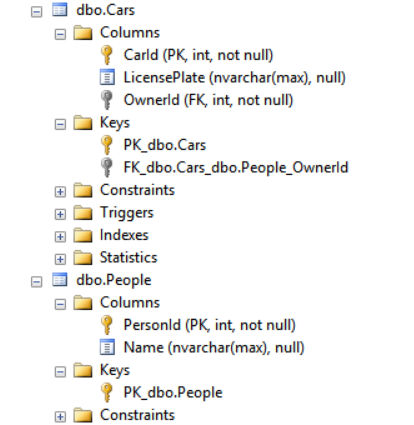Entity Framework Mapping relationship with Entity Framework Code First: One-to-many and Many-to-many Mapping one-to-many: against the convention
Example
In the last example, you can see that EF figures out which column is the foreign key and where should it point to. How? By using conventions. Having a property of type Person that is named Person with a PersonId property leads EF to conclude that PersonId is a foreign key, and it points to the primary key of the table represented by the type Person.
But what if you were to change PersonId to OwnerId and Person to Owner in the Car type?
public class Car
{
public int CarId { get; set; }
public string LicensePlate { get; set; }
public int OwnerId { get; set; }
public virtual Person Owner { get; set; }
}
Well, unfortunately in this case, the conventions are not enough to produce the correct DB schema:

No worries; you can help EF with some hints about your relationships and keys in the model. Simply configure your Car type to use the OwnerId property as the FK. Create an entity type configuration and apply it in your OnModelCreating():
public class CarEntityTypeConfiguration : EntityTypeConfiguration<Car>
{
public CarEntityTypeConfiguration()
{
this.HasRequired(c => c.Owner).WithMany(p => p.Cars).HasForeignKey(c => c.OwnerId);
}
}
This basically says that Car has a required property, Owner (HasRequired()) and in the type of Owner, the Cars property is used to refer back to the car entities (WithMany()). And finally the property representing the foreign key is specified (HasForeignKey()). This gives us the schema we want:

You could configure the relationship from the Person side as well:
public class PersonEntityTypeConfiguration : EntityTypeConfiguration<Person>
{
public PersonEntityTypeConfiguration()
{
this.HasMany(p => p.Cars).WithRequired(c => c.Owner).HasForeignKey(c => c.OwnerId);
}
}
The idea is the same, just the sides are different (note how you can read the whole thing: 'this person has many cars, each car with a required owner'). Doesn't matter if you configure the relationship from the Person side or the Car side. You can even include both, but in this case be careful to specify the same relationship on both sides!
